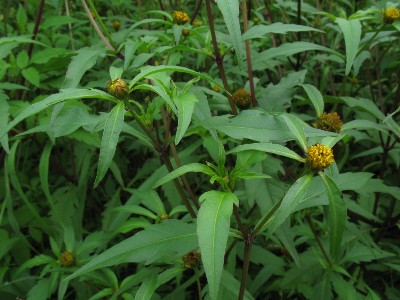1. Bidens connata Muhlenb. ex Willd. (N-Am.) – A rare, locally naturalised alien. First discovered alongside the Kanaal Bocholt-Herentals near Rijkevorsel in 1920 but this record probably was merely ephemeral. New records in the Kempen are available from the 1950’s onwards, apparently at first from the surroundings of Geel. At present Bidens connata is more or less widely dispersed in the Kempen (Verloove 2006a). In Wallonia it is documented since 1942 from river Meuse, at first around Seraing and Hermalle. It was also claimed from river Schelde but this requires confirmation. Furthermore recorded in several additional localities but probably mostly ephemeral or as a result of confusion with entire-leaved forms of native Bidens tripartita.
Bidens connata seems to prefer damp, nitrophilous habitats, often on sandy substratum. It has been recorded in cracks in stonework (canals) and pond margins. In some localities it penetrates in nature reserves (for instance in ‘De Zegge’ in Geel or in 'Buitengoor' near Mol), apparently – at least for the time being – without being considered a noxious environmental weed.
Only fruiting plants of Bidens connata can be distinguished with confidence from B. tripartita. Its ripe achens are conspicuously angular with four more or less equal, warty sides.
Interestingly, molecular analyses have demonstrated that Russian claims of Bidens connata in fact are referable to hybrids between American B. frondosa and native B. cernua (Galkina & Vinogradova 2017, 2020).
 |
 |
 |
 |
 |
Selected literature:
Ballintijn K.J.F. (1997) Over de verspreiding binnen Nederland van Bidens connata var. fallax (Warnst.) Sherf en var. anomala Farw. Gorteria 23(1-2): 20-24.
Bogosavljević S.S. & Zlatković B.K. (2015) Two alien species of Bidens (Compositae), new to the flora of Serbia. Phytologia Balcanica 21(2): 129-138. [available online at: http://www.bio.bas.bg/~phytolbalcan/PDF/21_2/PhB_21_2_04_Bogosavljevic_&... ]
Burton R.M. (1978) Bidens connata. BSBI News 18: 15-16.
Burton RM. (1979b) Bidens connata Muhl. Watsonia 12(4): 391-392.
Galkina M. & Vinogradova Y.K. (2017) Hybridization of alien and aboriginal taxons of Bidens L. genus in Eastern Europe. Biology Bulletin 44(4): 406-411.
Galkina M.A. & Vinogradova Y.K. (2020) Hybridogenic Activity of Invasive Species of Asteraceae. In: Invasive Species - Introduction Pathways, Economic Impact, and Possible Management Options. Available online at: https://www.researchgate.net/publication/340803917_Hybridogenic_Activity...
Nehon J. (1956) Remarques sur deux Bidens (Composées) d'origine américaine: B. frondosa L. et B. connata Mühl. Bull. Soc. Sci. Bretagne 30: 49-57.
Palmer J.R. (1984) Bidens connata in the Thames Estuary. BSBI News 37: 24.
Verloove F. (2002) Ingeburgerde plantensoorten in Vlaanderen. Mededeling van het Instituut voor Natuurbehoud n° 20: 227 p.
Verloove F. (2006b) Bidens frondosa. In: Van Landuyt W., Hoste I., Vanhecke L., Van den Bremt P., Vercruysse W. & De Beer D., Atlas van de flora van Vlaanderen en het Brussels gewest. Instituut voor Natuur- en Bosonderzoek, Nationale Plantentuin van België en Flo.Wer: 185.

